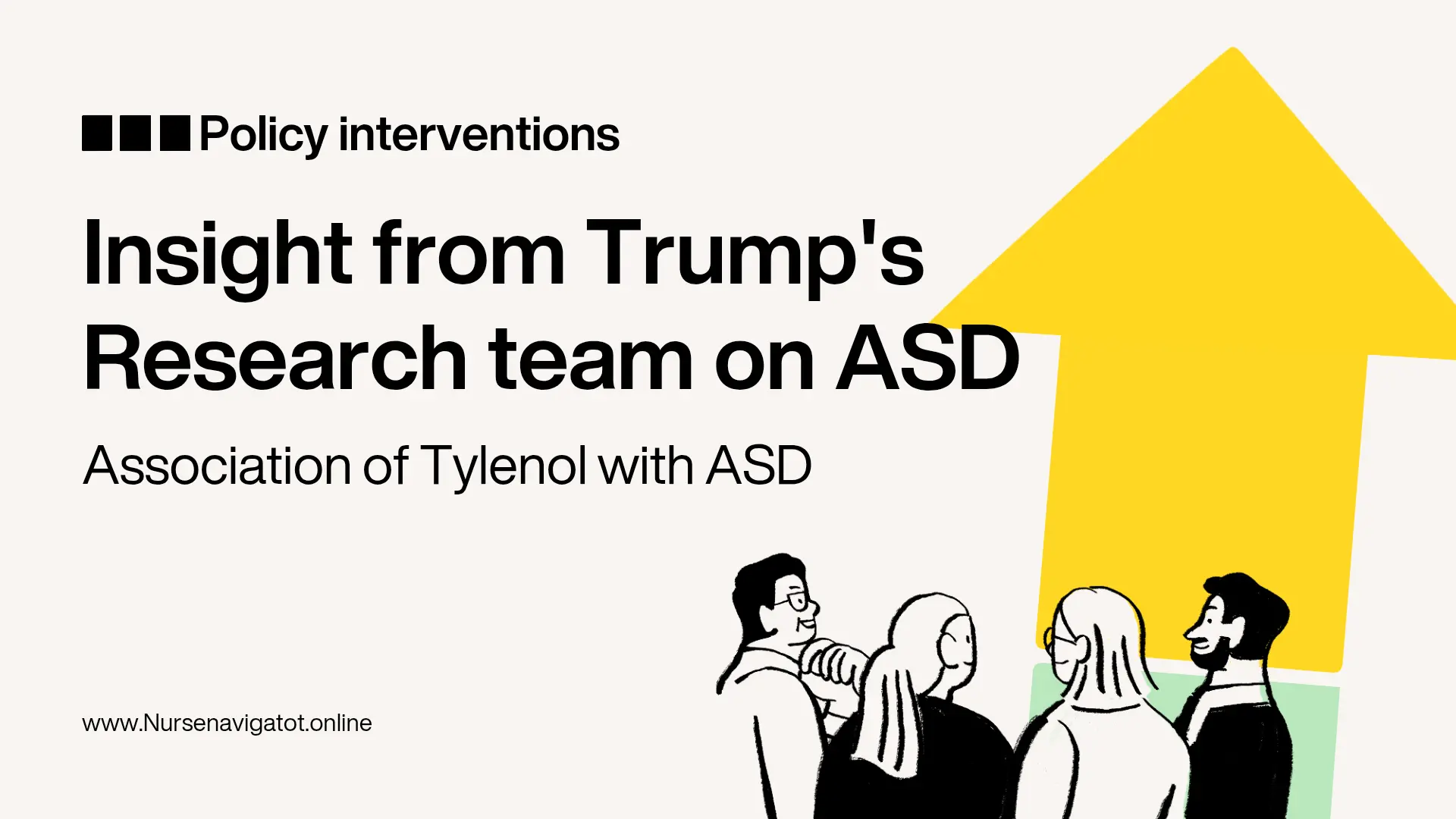Insights from President Trump’s 2025 Folinic Acid Research on autism, Myths and Facts.
Published: 25 Sep 2025

Folinic acid for Autism Spectrum Disorder (ASD), often simply referred to as autism, is a complex neurodevelopmental condition characterized by challenges in social communication, repetitive behaviors, and restricted interests. According to the Centers for Disease Control and Prevention (CDC), ASD affects approximately 1 in 31 children in the United States as of 2025, marking a significant rise from 1 in 36 just two years prior and nearly five times higher than rates observed in 2000 (1 in 150).
This increase underscores the urgency for ongoing research into autism causes, early diagnosis, and effective interventions.ASD is not a single disorder but a spectrum, ranging from individuals who require substantial support to those who live independently. Key symptoms often emerge in early childhood, including difficulties with eye contact, delayed speech, sensory sensitivities, and intense focus on specific topics. While genetics play a primary role—accounting for up to 80-90% of risk factors—environmental influences during pregnancy and early development also contribute. Early identification is crucial, as interventions like behavioral therapy can significantly improve outcomes.
Overview of using Folinic Acid as Autism Treatment
In this comprehensive guide, we’ll explore the latest developments in autism research, including President Donald Trump’s administration’s bold 2025 initiatives. We’ll delve into why these efforts were launched, their purpose and goals, perspectives from doctors and healthcare teams, CDC updates, the persistent myth linking autism to vaccines, the mechanism of action of Tylenol (acetaminophen), and cutting-edge studies on folinic acid (leucovorin) as a potential treatment for autism symptoms.
President Trump’s Team and the Latest Autism Research Initiatives (2025)
On September 22, 2025, President Trump, alongside Health and Human Services (HHS) Secretary Robert F. Kennedy Jr., announced a multifaceted federal response to the “autism epidemic” during a White House press conference.
This initiative, described as “unprecedented,” involves collaboration across the National Institutes of Health (NIH), Food and Drug Administration (FDA), and Centers for Medicare & Medicaid Services (CMS). Key components include:
- Autism Data Science Initiative (ADSI): The NIH awarded over $50 million to fund 13 research projects aimed at uncovering biological, environmental, and genetic root causes of ASD. These projects emphasize community engagement to ensure research aligns with the needs of autistic individuals and families.
- Leucovorin (Folinic Acid) as a Treatment Pathway: The FDA is expediting labeling updates for leucovorin—a form of folate traditionally used in cancer treatment—to address symptoms in children with cerebral folate deficiency (CFD), a condition linked to some ASD cases. CMS will guide states in supporting data collection for further studies while protecting patient privacy.
- Acetaminophen (Tylenol) Safety Review: The FDA issued a physician notice recommending minimized use of acetaminophen during pregnancy, citing observational evidence of potential links to neurodevelopmental disorders like ASD and ADHD.
This includes initiating safety label changes for over-the-counter products.These actions build on a five-month HHS-led review of 30 hypotheses, including mitochondrial dysfunction and microbiome alterations, representing a shift toward rapid, inter-agency action on autism causes and treatments.
Why Did President Trump Order This Autism Research? The Purpose and Goals
President Trump’s decision to prioritize autism research stems from his long-standing personal concern over rising ASD rates, which he described as a “horrible crisis” and “one of the most important announcements” of his presidency. Influenced by Secretary Kennedy’s advocacy, rooted in his environmental health background and criticism of past federal research as “politically safe but fruitless”.
Trump challenged agencies in April 2025 to identify causes within months. This urgency was amplified by the CDC’s April 2025 report showing a 400% surge in prevalence since 2000, disproportionately affecting boys (1 in 20) and regions like California (1 in 12.5).
The purpose of these initiatives is
- To address the lack of scientific consensus on ASD causes
- Provide immediate relief to families
- Restore public trust in health research.
- By acting on emerging signals
- Like folate deficiencies
- prenatal exposure
- The administration aims to prevent future cases and offer tangible treatments where few exist.
Goals include
- Uncovering preventable environmental and pharmaceutical triggers through data-driven studies.
- Developing the first FDA-recognized pharmacological pathway for ASD symptom management.
- Ensuring equitable access to research and interventions via state networks.
- Delivering hope to millions of families by translating findings into actionable guidelines within a year.
- Trump emphasized, “Nothing bad can happen; only good can happen,” highlighting a proactive stance on autism prevention and support.
Perspectives from Doctors, Healthcare Teams, and Autism Advocates
The medical community offers a mixed response to Trump’s autism research push, praising increased funding while cautioning against unsubstantiated claims. Dr. Jay Bhattacharya, NIH Director, lauded the ADSI as “gold standard science” to help families, noting its focus on root causes like genetics and environment.
FDA Commissioner Dr. Marty Makary highlighted leucovorin’s potential for folate-deficient children, based on peer-reviewed evidence showing verbal improvements in up to 60% of cases.However, organizations like the American Academy of Pediatrics (AAP), American College of Obstetricians and Gynecologists (ACOG), and Autism Science Foundation (ASF) expressed alarm.
ASF President Alison Singer called the Tylenol warnings “not scientifically based,” citing conflicting studies and risks of untreated fever in pregnancy. The American Psychiatric Association stressed that leucovorin requires “many more years of research” and rejected vaccine-autism links as debunked.Healthcare teams, including nurses from sources like Potter and Perry’s Fundamentals of Nursing (11th ed., 2023), emphasize holistic care: early screening, family education, and multidisciplinary support.
Dr. Irva Hertz-Picciotto, an autism epidemiologist, warned of eroded trust, stating, “Unrealistic expectations could taint everything from the administration.” Overall, while funding is welcomed for advancing ASD interventions, experts urge evidence-based caution to avoid misinformation.
CDC Updates on Using Folinic Acid For Autism Spectrum Disorder (September 2025)
The CDC’s Autism and Developmental Disabilities Monitoring (ADDM) Network continues to track ASD prevalence through active surveillance in 16 U.S. sites. As of the April 2025 MMWR report—still the most recent as of September—ASD identification among 8-year-olds reached 1 in 31 (3.2%), up from 1 in 36 in 2020 data. Among 4-year-olds, rates were 1 in 44, with early identification improving (median diagnosis age now under 4 years).
Key 2025 insights:
- Demographic Disparities: Higher rates among boys (4:1 ratio) and in high-social-vulnerability communities.
- Research Focus: Emphasis on social determinants, co-occurring conditions (e.g., ADHD in 40% of cases), and early interventions.
- No New Causes Identified: CDC reaffirms multifactorial etiology—genetics, prenatal factors—without endorsing specific links like vaccines or acetaminophen.
- No major September updates were issued, but CDC stresses vaccination safety and calls for expanded screening. Community reports highlight regional variations, urging tailored support.
Why People Associate Autism with Vaccination: Debunking the Myth
The vaccine-autism myth persists despite decades of evidence, originating from a 1998 Lancet paper by Andrew Wakefield linking the MMR vaccine to ASD in 12 children. Retracted in 2010 for fraud and ethical violations—Wakefield lost his medical license—the study fueled fears amid rising diagnoses.
Why the association?
- Timing Coincidence: ASD symptoms often emerge around 12-18 months, coinciding with MMR vaccination.
- Thimerosal Shift: Post-1998, concerns moved to this mercury preservative (removed from most U.S. vaccines by 2001); studies found no link.
- Misinformation Amplification: Social media, celebrity endorsements, and parental anecdotes sustain it, despite 20+ large-scale studies (e.g., 2015 JAMA analysis of 95,000 children) showing no causal relationship.
- From Pharmacology for Nursing Care (11th ed., 2024), vaccines save lives without ASD risk. CDC, WHO, and IOM affirm: No ingredient or schedule causes autism. This myth endangers herd immunity, contributing to outbreaks like 2019 measles.
Mechanism of Action of Tylenol (Acetaminophen):
Implications for Prenatal UseTylenol, or acetaminophen, is a widely used analgesic and antipyretic, recommended for mild pain and fever. Its exact mechanism remains partially elusive but involves central nervous system (CNS) actions rather than peripheral inflammation like NSAIDs.Primarily, acetaminophen inhibits cyclooxygenase (COX) enzymes—specifically a COX-3 variant—in the brain, reducing prostaglandin synthesis that amplifies pain signals and elevates the hypothalamic set-point for fever.
This leads to analgesia via serotonin modulation and endocannabinoid activation (via metabolite AM404), promoting vasodilation, sweating, and heat loss.Unlike aspirin, it doesn’t irreversibly bind COX, explaining minimal GI side effects.
At therapeutic doses (up to 4g/day), it’s safe; overdose risks hepatotoxicity via NAPQI metabolite.In pregnancy, while deemed safest for fever/pain, Trump’s 2025 review cites observational links to ASD/ADHD. A 2025 BMC Environmental Health meta-analysis of 46 studies found associations but no causation, advising lowest-dose/shortest-duration use. ACOG maintains its safety profile.
Folinic Acid (Leucovorin) as an Effective Treatment for Autism:
Latest Research from Google Scholar (2023-2025)Some claim folinic acid (leucovorin), a reduced folate bypassing defective transport, treats ASD by addressing cerebral folate deficiency (CFD) in FRA-autoantibody cases (up to 60% of ASD children). From Pharmacology and the Nursing Process (9th ed., 2023), folates support neurodevelopment; deficiencies impair methylation and neurotransmitter synthesis.
Latest Google Scholar studies (2023-2025) show promise but call for more RCTs:
- Folinic Acid and ASD in Children: Systematic Review and Meta-Analysis (Soetedjo et al., 2025): Meta-analyzed 103 children from two RCTs; moderate symptom improvements (e.g., verbal communication) in FRA+ cases. Conclusion: Safe adjunct; larger trials needed.Folinic Acid Supplementation During Pregnancy in FRA+ Women (Giorlandino et al., 2025): Case study of two mothers; offspring avoided ASD traits. Mechanism: Enhances fetal folate delivery. Conclusion: Preventive potential in high-risk pregnancies.High-Dose Folinic Acid in ASD: Impact of Folate Gene Polymorphisms (Zhang et al., 2025): In 48 children, polymorphisms predicted responders (76% improvement in adaptive skills). Conclusion: Genetic screening could personalize treatment.
- Open-Label Study on Folinic Acid Safety/Efficacy in ASD (Wong et al., 2025): 35 children; 40% showed language gains after 12 weeks (2mg/kg/day).
Conclusion: Navigating Autism with Evidence and Hope
Autism Spectrum Disorder demands a balanced approach: robust research, myth-busting, and compassionate care. Trump’s 2025 initiatives inject urgency and funding, potentially yielding breakthroughs in ASD causes and treatments like leucovorin.
Yet, as CDC data and medical consensus highlight, vaccines save lives without risk, and Tylenol remains a pregnancy staple when judicious.For families, early intervention—drawing from nursing texts like Fundamentals of Nursing is key. Consult providers for personalized plans. By prioritizing science over sensationalism, we can foster a supportive ecosystem for autistic individuals to thrive.

- Be Respectful
- Stay Relevant
- Stay Positive
- True Feedback
- Encourage Discussion
- Avoid Spamming
- No Fake News
- Don't Copy-Paste
- No Personal Attacks

- Be Respectful
- Stay Relevant
- Stay Positive
- True Feedback
- Encourage Discussion
- Avoid Spamming
- No Fake News
- Don't Copy-Paste
- No Personal Attacks


